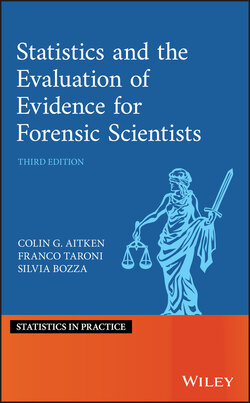Читать книгу Statistics and the Evaluation of Evidence for Forensic Scientists - Franco Taroni - Страница 28
1.7.3 Events
ОглавлениеThe outcome of the drawing of a ball from the urn was called an event. If the ball was black, the event was denoted . If the ball was white, the event was denoted . It was not certain which of the two events would happen: would the ball be black, event , or white, event ? The degree of uncertainty of the event ( or ) was measured by the proportion of balls of the appropriate colour ( or ) in the urn and this proportion was called the probability of the event ( or ). In general, for an event , denotes the probability that occurs.
As underlined by Lindley (2014), events may have happened (past events), may be relevant at the present time (present events), or may happen in the future (future events).
There are some things that you [ ] know to be true, and others that you know to be false; yet, despite this extensive knowledge that you have, there remain many things whose truth or falsity is not known to you. We say that you are uncertain about them. You are uncertain, to varying degrees, about everything in the future; much of the past is hidden from you; and there is a lot of the present about which you do not have full information. (p. xi)
So, a person may be uncertain about each of these three types of events. Such uncertainty can be expressed by probability.
Past event: A crime is committed and a bloodstain with a particular DNA profile is found at the crime scene. A PoI is found. The event of interest is that the suspect is the source of the stain at the crime scene. Though the PoI either is or is not the source of the stain the knowledge of it is incomplete and hence there is uncertainty about this event. This uncertainty can be expressed by probability.
Present event: A PoI is identified. The event of interest is that they have a particular DNA profile (e.g. Y‐STR haplotype). Again, before the result of a DNA analysis is available, this knowledge is incomplete.
Future event: The event of interest is that it will rain tomorrow.
All of these events are uncertain and have probabilities associated with them. Notice, in particular, that even if an event has happened, its actual outcome may be unknown so that knowledge about it is incomplete. The probability the PoI is the source of the stain at the crime scene requires consideration of many factors, including the possible location of the PoI at the crime scene and the properties of transfer of blood from a person to a site. With reference to the gene expression, consideration has to be given to the proportion of people in some population with that gene expression. Probabilistic statements are common with weather forecasting. Thus, it may be said, for example, that the probability it will rain tomorrow is 0.8 (though it may not always be obvious what this means).
